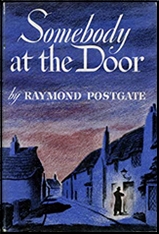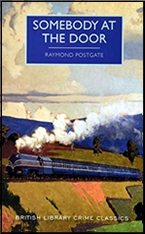Wed 3 Aug 2022
A Mystery Review by David Vineyard: RAYMOND POSTGATE – Somebody at the Door.
Posted by Steve under Reviews[3] Comments
RAYMOND POSTGATE – Somebody at the Door. Inspector Holly #1. M. Joseph, UK, hardcover, 1943. Knopf, US, hardcover, 1943. Poisoned Pen Press (British Library Crime Classic), US, trade paperback, 2017.
It is a dreary day in January 1942 in the middle of the War.

On this dreary day probably the dreariest place was a railway terminus. Those who were hurrying to catch the 6.12 at Euston may have thought so, if they had any thoughts to spare from their aching ears and fingers. One of them, Councillor Henry James Grayling, a thin man looking about 50, cursed the station and the railway company aloud.
Grayling finds more reason to grumble before the evening is out, because there are five people aboard who he has little reason to care for, including his Vicar, a German refugee, a young man with a club foot, a corporal from his Home Guard unit, and a man from work. None of them have much reason to like Grayling either, one of them enough to murder him, leaving it up to Inspector Holly to sort out not only how Grayling was murdered, and it is one unique to the books wartime setting, but which, if any of the five men aboard might have done it. Not to mention that inevitable sixth, if unlikely, suspect in any man’s murder, his widow.
Despite that unique murder weapon, this might sound like just any fairly well written mystery of the Golden Age, but only if the reader doesn’t know who Raymond Postgate was, one of the more interesting and innovative writers of the era who penned only three books, but the first of those a small masterpiece, Verdict of Twelve in which he dissects the twelve jurors on a murder case, one of which is closer to the case than might be good for them. His final book The Ledger is Written came ten years after Someone, and while like Someone is not quite up to the classic status of Verdict is yet another intelligent and quite different take on the genre.
The chapters are divided up between the suspects with each having his story told, what exactly their grievance with Grayling was and their availability to have murdered him, and Holly’s investigation. Each has a plausible motive and plausible means, and as the canny Holly examines them and weighs them we also get plausibly and engagingly drawn portraits of ordinary people with rather ordinary motives for murder, and of Grayling himself, who like the victims of many of Golden Age mystery thoroughly deserves what he gets.

“You’ve got too many suspects. And I’m afraid you’ve got to add some more. Have you remembered the two workmen? One of them, the Vicar said, leant over his and Grayling’s shoulder on the pretext of reading a notice. Quite an opportunity for planting that handkerchief, if it existed.â€
A veritable embarrassment of suspects, any one of whom, or someone else, might be the killer, because no one is quite innocent with everything from wartime espionage to adultery in the possible mix.
The killer though is quite logical, quite reasonable when you get down to it as is the rather bizarre weapon, but it is still a fine ride, thanks to Postgate’s literate hand and sharp eye.
These people were unrelated. They were each one individual persons—who were important — “valid†would be the literary cant word — in themselves and must be looked at alone. Then, maybe, he could find which one would carry on into the next episode and which would vanish and be forgotten. They did not, in fact, did they, have any other connection than that they had travelled in a single coach on a single journey, which had a relation with the crime. If it did have.
I’m not sure any mystery writer of the classical or noir form ever put the sheer chance of being thrown in the limelight by fate half as clearly. The murderer was merely someone at the door, and could be anyone, but fate chose a handful of innocents to be thrown beneath the same glaring light as the guilty, and Raymond Postgate makes that almost as suspenseful as revealing which one was not merely a traveller on a train.
This is available from the British Library Crime Classics collection, and like all books in that series has a fine introduction by Martin Edwards.
August 3rd, 2022 at 8:58 pm
Add another one to my want list. I passed on it when it first came out, but that was before I read your review, David. Now it’s a must.
August 4th, 2022 at 12:08 pm
David,
Not into reading British prose much these days—but I have to say your reviews are astoundingly well written and if I don’t end up reading any Postgate his ghost could certainly not complain about your representation nor ask for a better presentation of his work in a tempting manner.
Please keep ‘em coming. Your reviews and comments are some of my favorite things on the internet.
Tony
August 4th, 2022 at 6:57 pm
With Postgate you just let the writer speak for himself and try to pick a few key passages that show what he can do while trying to give away as little as possible.
With only three titles he’s a good place to start a collection of Golden Age British crime writers.